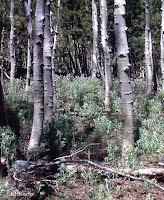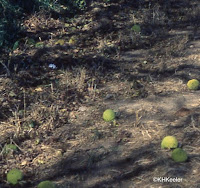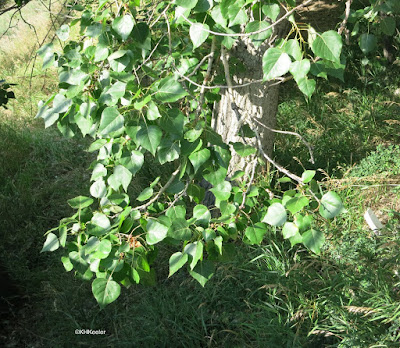Cottonwood leaves are almost always in motion, no matter how still the air.
The tribes of the northern plains revered the cottonwood--big, sturdy trees found in diverse locations, often indicating water. The rustling leaves reinforced the mystic nature of the tree because winds were the path of the Higher Powers and cottonwoods always have those inexplicable little winds moving their leaves. Check for yourself.
Across a large area of the central North America, the cottonwood, Populus deltoides (willow family, Salicaceae) is far the largest native tree. In the grasslands, cottonwoods stand out.
The North American prairies and plains are dry, maybe 36" rain annually on the east (western Ohio, western Tennessee) to 15" or less at the base of the Rocky Mountains. When Europeans arrived, a treeless sea of grass extended for hundreds of miles. On the eastern half, recurrent fires destoryed the trees. On the western half, drought killed them. For people from the forests of Europe and eastern North America, a treeless land was bleak and uninviting.
Cottonwoods were the biggest exception. Cottonwood seeds are tiny enough to fly through the air, so they have virtually no resources to keep the seedling alive. Consequently them must land in a moist spot and germinate quickly. Big plants require more water than small plants. Those cottonwood seedlings that survived to become big trees did so only where they had an ample supply of water. Both Native Americans and settlers who spotted a cottonwood on the horizon knew that it likely indicated water.
Fast forward to today. Cottonwoods are banned from many neighborhoods. The trees grow too big. The heavy branches break off in high winds. The roots lift up under sidewalks and patios, destroying them. And the cotton, the fluff that lets the tiny seeds fly, lodges in window screens and screen doors, infuriating tidy housewives.
All true.
Cottonwoods are fast growing trees. They can grow three feet a year, and easily reach 70'. The current U.S. record-holder for eastern cottonwood, Populus deltoides ssp. deltoides is a tree just north of Beatrice, Nebraska that is 88 feet tall, 450' in canopy circumference, with a 108' crown spread (canopy diameter)(link). The champion plains cottonwood, Populus deltoides ssp. monilifera is in Ravalli, Montana and stands 112 feet tall, with a 394' circumference and a 94' crown spread. (link).
For a big tree, they don't live very long, expect 40-50 years. A few individuals make it to 70 and very infrequently 120. The trees the pioneers saw on the prairie are just about all gone now.
The branches are weak and the wide stems subject to internal rot, so there's a fair amount of litter after a windstorm and periodically dangerously big branches fall.
The roots seek water, along the surface where they disturb pavement and downward where they can follow moisture into a basement or water pipes.
Cottonwoods are dioecious--each plant is either male, producing pollen but no seeds, or female, producing seeds but no pollen. Homeowners are happier with male trees because male trees don't produce the clouds of tiny seeds riding the wind on white cottony fibers. --Unless they are allergic to cottonwood pollen, which the males produce in copious amounts.
But I am an advocate for cottonwood trees. If you name an animal in the central United States that nests in trees, dens in holes in trees, or sleeps in trees, it uses cottonwoods. Bats, large and small birds, opossums and squirrels... over 40 vertebrate species. Eagles nest high in cottonwoods, wild turkeys roost in their branches. The holes in old cottonwoods have residents from raccoons to owls. Bees and other insects rely on them. In regions where trees are few and big trees even fewer, cottonwoods provide a critical resource.
And that is not mentioning all the animals that eat cottonwood leaves and bark. Those range from deer and rabbits to beaver. Many insects, including the larvae of native butterflies, such as the tiger swallowtail (Papilio glaucus photos) eat cottonwood, enhancing its value to birds as a nest-tree since those insects and the spiders that hunt them, are wonderful food for nestling birds.
The balance between dense modern towns and places for big native trees is tricky but we must not eliminate cottonwoods just because we aren't comfortable with them in small back yards. Along streams, in wetlands, in parks and natural areas, in these places we should cherish and encourage cottonwoods. And then watch for the animals they attract.
Comments and corrections welcome.
ssp. = subspecies, a recognizeable, usually regional, variety of the species
All the champion cottonwoods: Champion Trees National Register American Forests.com link
Newspaper articles with more information:
Anderson, J. Cottonwood tree near Beatrice a national champion. Omaha World-Herald. Oct. 2, 2013. Accessed 11/23/17
Fryar, J. Boulder County's national champion plains cottonwood tree has died. Longmont Times Call. 6/04/12 link Accessed 11/25/17
St. Vrain, J. Johnnie St. Vrain: Of champion cottonwoods and competitive tree measuring. Longmont Times Call 10/01/14 link Accessed 11/25/17
Note on Names: The literature is contradictory on the distribution of the various subspecies of cottonwood. The Flora of North America dropped the common name eastern cottonwood for Populus deltoides ssp. deltoides calling it the southern cottonwood. The USDA Plants website uses the name eastern cottonwood for Populus deltoides ssp. deltoides but on the map the tree's range stops in Iowa. Yet the American Forest website puts the national record largest tree of Populus deltoides spp. deltoides eastern cottonwood, as Beatrice, Nebraska. That's southeastern Nebraska but the USDA map doesn't have Populus deltoides ssp. deltoides in Kansas either. I find subspecies a finer division than I am usually interested it. Since eastern/southern cottonwoods and plains cottonwoods (Populus deltoides ssp. monilifera) are both Populus deltoides, they cross freely. And are sufficiently similar that all the information above applies to both. However, if you want to enter your tree in the national champion tree competition, you have to work out which subspecies it is (see key in Flora of North America link).
References
Eckenwalder, J. E. Populus. Flora of North America. link Accessed 11/23/17.
Gilmore, M. R. 1911-12. Uses of plants by the Indians of the Missouri River Region. 33rd Annual Report, Bureau of American Ethnography online link
Illinois Wildflowers. Trees. Eastern cottonwood. link 11/21/17.
Ten Favorite Trees for Wildlife. The National Wildlife Federation blog link 11/21/17.
National Park Service. Eastern Cottonwood. link
U.S. Forest Service. Populus deltoides link
Fast forward to today. Cottonwoods are banned from many neighborhoods. The trees grow too big. The heavy branches break off in high winds. The roots lift up under sidewalks and patios, destroying them. And the cotton, the fluff that lets the tiny seeds fly, lodges in window screens and screen doors, infuriating tidy housewives.
All true.
Cottonwoods are fast growing trees. They can grow three feet a year, and easily reach 70'. The current U.S. record-holder for eastern cottonwood, Populus deltoides ssp. deltoides is a tree just north of Beatrice, Nebraska that is 88 feet tall, 450' in canopy circumference, with a 108' crown spread (canopy diameter)(link). The champion plains cottonwood, Populus deltoides ssp. monilifera is in Ravalli, Montana and stands 112 feet tall, with a 394' circumference and a 94' crown spread. (link).
For a big tree, they don't live very long, expect 40-50 years. A few individuals make it to 70 and very infrequently 120. The trees the pioneers saw on the prairie are just about all gone now.
The branches are weak and the wide stems subject to internal rot, so there's a fair amount of litter after a windstorm and periodically dangerously big branches fall.
 |
| Making chips of big cottonwood branches |
 |
| Cottonwood seeds on the ground |
And that is not mentioning all the animals that eat cottonwood leaves and bark. Those range from deer and rabbits to beaver. Many insects, including the larvae of native butterflies, such as the tiger swallowtail (Papilio glaucus photos) eat cottonwood, enhancing its value to birds as a nest-tree since those insects and the spiders that hunt them, are wonderful food for nestling birds.
The balance between dense modern towns and places for big native trees is tricky but we must not eliminate cottonwoods just because we aren't comfortable with them in small back yards. Along streams, in wetlands, in parks and natural areas, in these places we should cherish and encourage cottonwoods. And then watch for the animals they attract.
Comments and corrections welcome.
ssp. = subspecies, a recognizeable, usually regional, variety of the species
All the champion cottonwoods: Champion Trees National Register American Forests.com link
Newspaper articles with more information:
Anderson, J. Cottonwood tree near Beatrice a national champion. Omaha World-Herald. Oct. 2, 2013. Accessed 11/23/17
Fryar, J. Boulder County's national champion plains cottonwood tree has died. Longmont Times Call. 6/04/12 link Accessed 11/25/17
St. Vrain, J. Johnnie St. Vrain: Of champion cottonwoods and competitive tree measuring. Longmont Times Call 10/01/14 link Accessed 11/25/17
Note on Names: The literature is contradictory on the distribution of the various subspecies of cottonwood. The Flora of North America dropped the common name eastern cottonwood for Populus deltoides ssp. deltoides calling it the southern cottonwood. The USDA Plants website uses the name eastern cottonwood for Populus deltoides ssp. deltoides but on the map the tree's range stops in Iowa. Yet the American Forest website puts the national record largest tree of Populus deltoides spp. deltoides eastern cottonwood, as Beatrice, Nebraska. That's southeastern Nebraska but the USDA map doesn't have Populus deltoides ssp. deltoides in Kansas either. I find subspecies a finer division than I am usually interested it. Since eastern/southern cottonwoods and plains cottonwoods (Populus deltoides ssp. monilifera) are both Populus deltoides, they cross freely. And are sufficiently similar that all the information above applies to both. However, if you want to enter your tree in the national champion tree competition, you have to work out which subspecies it is (see key in Flora of North America link).
References
Eckenwalder, J. E. Populus. Flora of North America. link Accessed 11/23/17.
Gilmore, M. R. 1911-12. Uses of plants by the Indians of the Missouri River Region. 33rd Annual Report, Bureau of American Ethnography online link
Illinois Wildflowers. Trees. Eastern cottonwood. link 11/21/17.
Ten Favorite Trees for Wildlife. The National Wildlife Federation blog link 11/21/17.
National Park Service. Eastern Cottonwood. link
U.S. Forest Service. Populus deltoides link
Kathy Keeler, A Wandering Botanist
More at awanderingbotanist.com
Join me on Facebook: https://www.facebook.com/AWanderingBotanist
You might also like these posts:
Aspen: widespread and spreading link

You might also like these posts:
Aspen: widespread and spreading link

Osage-orange, aka bodark, horse apple and more: The many uses of osage-orange link 






I remember the amazing sight of several Baltimore Oriole nests high in a cottonwood tree. Someday I hope to have a home acreage large enough to allow the back several acres to grow semi-wild, so we can accommodate such nesting areas.
ReplyDeleteVery interesting blog Really excellent information and thank you for giving your valuable information. https://www.jacksonvillenctree.com
ReplyDelete